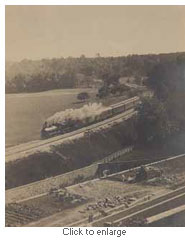The Photography of Francis Blake
Exploring a Massachusetts inventor's fascination with photography during the late 19th century
by Megan K. Friedel, MHS Photograph Cataloger.
Biography
 Francis Blake was born in Needham, Mass. in 1850. In his early years, he was a scientist who worked on the United States Coast Survey and Darien Exploring Expedition from 1866-1874 -- but later in life he also became an accomplished inventor and photographer. Blake's curiosity about the workings of instruments and tools first led him to experiments with early telephone technology during the late 1870s. By 1878, he had developed the Blake Transmitter for telephone communications, used widely by the Bell Telephone Company. Francis Blake brought this same ingenuity and creativity to the construction of his elaborate family estate, Keewaydin, in Weston, Mass., which he designed and built in 1875 with the help of renowned architect Charles Follen McKim. The house provided a continual outlet for Blake's tinkerings: over the next ten years, he installed an innovative heating system, a self-contained, steam-powered waterworks for the entire grounds, and built many of the machines that ran these systems himself.
Francis Blake was born in Needham, Mass. in 1850. In his early years, he was a scientist who worked on the United States Coast Survey and Darien Exploring Expedition from 1866-1874 -- but later in life he also became an accomplished inventor and photographer. Blake's curiosity about the workings of instruments and tools first led him to experiments with early telephone technology during the late 1870s. By 1878, he had developed the Blake Transmitter for telephone communications, used widely by the Bell Telephone Company. Francis Blake brought this same ingenuity and creativity to the construction of his elaborate family estate, Keewaydin, in Weston, Mass., which he designed and built in 1875 with the help of renowned architect Charles Follen McKim. The house provided a continual outlet for Blake's tinkerings: over the next ten years, he installed an innovative heating system, a self-contained, steam-powered waterworks for the entire grounds, and built many of the machines that ran these systems himself.
Photography was a natural interest for a man dedicated to pushing the limits of new technology. However, it wasn't until April of 1884 that Francis Blake bought his first camera. His passion for photography developed quickly, and later that year he built an extensive photographic laboratory on the grounds of Keewaydin. By October 1885, Blake had joined the progressive Society of Amateur Photographers of New York and had been elected a member of the Boston Camera Club. His photos began appearing in public exhibitions, where they were praised for their unusual clarity, detail, and, most of all, their realism and lack of formalism in scenes of everyday life and human character. Blake's innovations in high-speed photography earned him the most critical attention. In the mid-1880s, Blake designed a focal-plane shutter that allowed him to take photographs with exposure times of 1/1000 to 1/2000 of a second. (The average working speed of a contemporary commercial shutter was about 3/100 of a second.) The resulting stop-action images of trains, pigeons, horses, bicyclists, and athletes were exhibited in Boston, Philadelphia, and London from 1891 to 1893 to critical acclaim. The renowned pioneer of high-speed photography, Eadweard Muybridge, wrote to Blake to offer his congratulations on the images. Blake's photos of tennis players were included in the 1893 textbook Practical Lawn Tennis, by former champion James Dwight. Blake also published a well-received article on his research in high-speed photography, "Photographic Shutters," which was printed in two respected journals, American Amateur Photographer and Anthony's Photographic Bulletin, in 1891. 
Francis Blake did not seek public recognition, and he neither sold nor promoted his work. Indeed, Blake was more interested in the technical and scientific challenges of photography than its use as an artistic medium. His last public exhibit of his photographs was in April 1893 at the sixth Annual Exhibit of the Photographic Society of Philadelphia. Though he won a silver medal at the exhibit, Blake spent little time afterwards on photography. He retreated to Keewaydin and his family, devoting himself to public service and local government. In 1898, Blake created one last series of high-speed photographs of golfers, but his interest in the craft had largely waned. He died in 1913.
The Francis Blake Photographs at the Massachusetts Historical Society contain over 2,000 of Blake's photographs, as well as lantern slides, glass plate negatives and positives, and Blake's photo notebooks. Click here to access the finding aid to the Francis Blake Photographs. The Society also has the Francis Blake Papers, an extensive collection documenting Blake's scientific, photographic, and philanthropic interests, as well as those of his family. For information on this collection, please search ABIGAIL, the MHS online catalog.
The Massachusetts Historical Society is also pleased to announce the publication of a new biography of Francis Blake, Francis Blake: An Inventor's Life, 1850-1913, by Elton W. Hall (2003). To purchase a copy, please visit our online store.